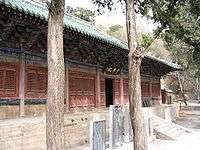Lingyan Temple (Jinan)
- Not to be confused with Lingyin Temple.

Lingyan Temple (simplified Chinese: 灵岩寺; traditional Chinese: 靈巖寺; pinyin: Língyán Sì; literally: "Temple of the Spiritual Rocks") is a Buddhist temple located in Changqing District, Jinan, Shandong Province, China, about 20 kilometres (12 mi) north of the city of Tai'an.[1] The temple grounds are situated in a valley on the western edge of the Taishan range. The Lingyan Temple has a long recorded history, and was one of the main temples in China during the times of the Tang and Song Dynasties. Its most renowned landmarks are the 11th century Pizhi Pagoda and the Thousand Buddha Hall which houses a Ming dynasty bronze Buddha statue as well as 40 painted clay statues of life-size luohan from the Song dynasty.[2]
History

The original temple was established in the Yongxing reign period (357–358), during the reign of Fú Jiān (r. 357–385) of the Former Qin state. Gaining a greater reputation during the Northern Wei (386–534), the temple reached its apex of importance during the Tang dynasty (618–907) and Song dynasty (960–1279). There were over 40 different wooden temple halls located at the temple, composing more than 500 monastic rooms.[3] More than 500 Buddhist monks lived at Lingyan Temple during its height.[1] The oldest structures at the site are the various stone stupas and square-based stone Chinese pagoda in the pavilion style from the Tang dynasty, the 8th century Huichong Pagoda. Of the 167 stone stupas at the temple, no two are identical, and like the luohan statues of the Thousand Buddha Hall, have been well preserved and untouched by the Cultural Revolution.[2] The tallest structure of the temple is the 54 m (177 ft) tall Pizhi Pagoda, built originally in 753, although the present structure was built from 1056 to 1063.[3][4] Although the wooden halls were all reconstructed during the Ming dynasty (1368–1644) and Qing dynasty (1644–1912), the stone pedestals at the base of the pillars in the Thousand Buddha Hall are the original work of the Tang and Song eras.[3]
Pagodas and stupas
 Pizhi Pagoda, built from 1056 to 1063 during the reign of Emperor Renzong of Song.
Pizhi Pagoda, built from 1056 to 1063 during the reign of Emperor Renzong of Song. Some of the 167 stupas in the stupa forest at Lingyan, some as old as the Tang dynasty, while some date as late as the Qing.
Some of the 167 stupas in the stupa forest at Lingyan, some as old as the Tang dynasty, while some date as late as the Qing.
See also
Notes
- 1 2 Valder, 118.
- 1 2 Valder, 119.
- 1 2 3 Lingyan Temple. From ChinaCulture.org. Retrieved on 2008-02-12.
- ↑ Pizhi Pagoda at Lingyan Temple in Changqing of Shandong Province. From China.org.cn. Retrieved on 2008-02-12.
References
- Valder, Peter. (2002). Gardens in China. Portland: The Timber Press, Inc. ISBN 0-88192-555-1.
External links
| Wikimedia Commons has media related to Lingyan Temple. |
Coordinates: 36°21′46″N 116°58′41″E / 36.36278°N 116.97806°E